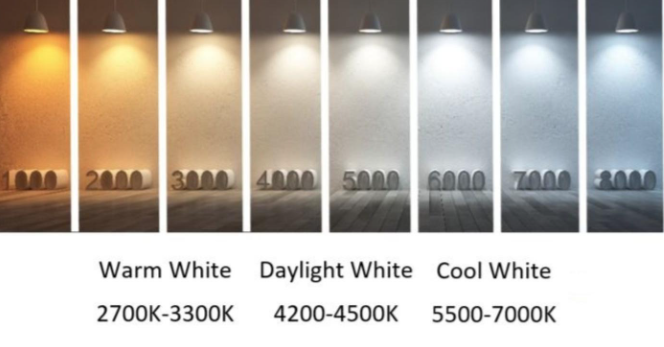The Choice of LED Light Color Temperature
Because both the color and temperature of LED lighting affect people's mood, we will choose LED lamps with different color temperatures in different places. For example, our kitchen may need a clean and bright feeling, so a color temperature of around 4,500K may be very suitable for it. On the contrary, our bedroom may be a place where you mainly use it to relax, which means that warm light around 3,000K may be a good choice.
When we buy LED lights, we must consider three things:
* Light color temperature
* Color temperature scale
* Color temperature matching requirements for various spaces in the home

1. Basic knowledge of LED color temperature
Color temperature is a unit of measurement that indicates the color component contained in light. In theory, the black body temperature refers to the color of an absolute black body after heating from absolute zero (-273℃). After being heated, the black body gradually changes from black to red, yellow, white, and finally emits blue light. When heated to a certain temperature, the spectral components of the light emitted by a black body are called the color temperature at this temperature, and the unit of measurement is "K" (Kelvin).
The unit of measurement for color temperature is Kelvin (K). The color temperature of a light source is determined by comparing its color with a theoretical hot black body radiator. The Kelvin temperature when the hot black body radiator matches the color of the light source is the color temperature of that light source, which is directly related to the Planck black body radiation law.
Different color temperatures of light sources bring different feelings. Under the irradiation of a high color temperature light source, if the brightness is not high, it will give people a cold feeling; under the irradiation of a low color temperature light source, if the brightness is too high, it will give people a stuffy feeling. The lower the color temperature, the warmer the color (redder); the higher the color temperature, the colder the color (bluer).
Color temperature is widely used in different fields. In the fields of photography, videography, publishing, etc., color temperature is used to indicate the color component of the light source. When shooting with natural light, the color of the photos taken is different due to the different color temperatures of the light in different time periods. Understanding the relationship between light and color temperature can help photographers shoot under different light conditions, calculate in advance what color tone of photos will be taken, and further consider whether to strengthen or weaken this tone.
2. Color temperature is mainly divided into the following categories:
Low color temperature: Usually between 2700K and 3500K, the light is reddish, giving people a warm and cozy feeling. Suitable for home bedrooms, cafes, hotels and museums.
Intermediate color temperature: Generally between 3500K and 5000K, the light is soft, suitable for various occasions, and can provide good lighting effects.
High color temperature: Above 5000K, the light is blue, giving people a cool and bright feeling. Suitable for places that require high illumination, such as kitchens, factories, conference rooms and libraries.
3. Application scenarios of different color temperatures
Low color temperature: Suitable for places that need to create a warm and comfortable atmosphere, such as home bedrooms, restaurants, hotels and cafes.
Intermediate color temperature: Suitable for various occasions, can provide good lighting effects, suitable for living rooms, restaurants and offices, etc.
High color temperature: Suitable for places that require high illumination, such as kitchens, factories, conference rooms and libraries, etc., which can enhance people's alertness.
Choosing the right LED lighting color can enhance the beauty of the space, increase our visual comfort, and make our lives more comfortable.
4. How to match color temperature with wall color
The matching method of color temperature and wall color mainly depends on the atmosphere you want to create and the function of the space. Here are some basic matching principles:
Bedroom: In order to create a warm and comfortable sleeping environment, it is recommended to use a lower color temperature, such as 3000K, which can provide warm light and help promote sleep. The wall color can choose soft tones, such as beige, light gray or light blue, to enhance the overall warm atmosphere.
Living room and dining room: For living rooms and dining rooms that need to create a relaxing and pleasant atmosphere, you can choose neutral light or a slightly higher color temperature, such as 4000K, which can provide soft and comfortable light without being too glaring. The wall color can be light yellow, off-white or light orange to enhance the brightness and warmth of the space.
Study and office: Spaces that require high concentration, such as study rooms and offices, should choose a higher color temperature, such as 5500K, which provides bright light and helps improve work efficiency. The wall color can be light blue, light green or off-white to reduce visual fatigue while providing a clear working environment.
Kitchen: As a space that requires bright light, the kitchen can choose a medium color temperature, such as 4000K, which can provide enough light for cooking and cleaning without being too glaring. The wall color can be light gray, white or light wood to enhance the brightness and neatness of the space.
In summary, choosing the right color temperature and wall color combination can not only improve the comfort of the living environment, but also create the most suitable living and working atmosphere according to different space functions and personal needs.
We Kofi Lighting are committed to the research ,development and production of LED lamps, providing people with cost-effective high-quality lamps to enhance people's life experience and happiness.
